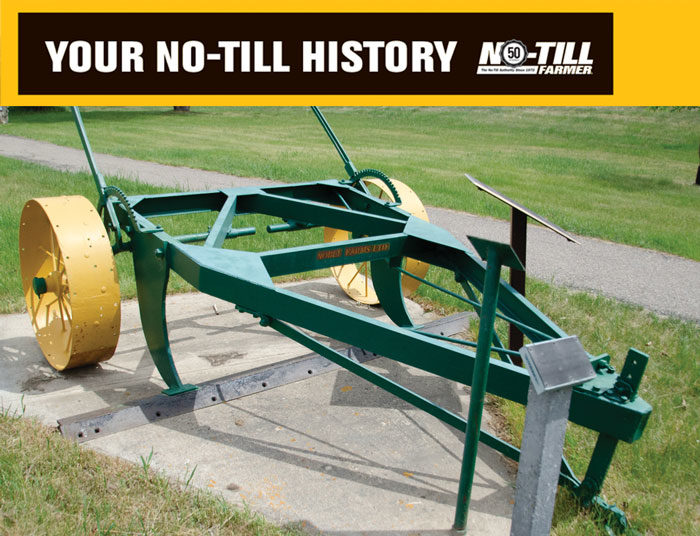The town of Nobleford, Alta., in Canada remains a significant place in no-till farming’s history. In response to extreme soil drifting in Western Canada, Charles Sherwood Noble developed a system to shear stubble and weeds below the ground and leave the residue on top of the soil to reduce evaporation and prevent erosion.
“The problem they were trying to solve was in a dry, windy location with a lot of soil erosion,” says Belinda Crowson, the president of the Lethbridge Historical Society, just Southeast of Nobleford. “The Noble blade kept moisture and soil in place.”
Noble History
No-Till Farmer’s editors took a trip to Nobleford this summer to explore this piece of agriculture’s history. The Noble blade was an 8-foot-wide straight blade with two vertical standards designed to leave trash above ground while cutting weeds at the roots to terminate them. Noble used an old grader blade with a borrowed forger and anvil for the initial design. He reshaped the blade and fixed it with two stout arms and a frame. He gave it 2 wheels and a means of depth control. The initial design wasn’t perfect, but it was functional.
“The blade passed through the soil at about a 30-degree angle about 6 inches down,” says Carlton Stewart, a Lethbridge historian who worked for Noble’s company for 19 years. “The blade was about 7 inches long. It really just moved the soil forward 2-3 inches, and then the soil just fell back off of the edge of the blade.”
“The Noble blade kept moisture and soil in place…”
In the first half of the 20th Century, western farmers and scientists sought effective dryland farming techniques, including different varieties of grain, crop rotation, strip farming and the use of a protective “trash cover” of vegetation left on the soil to keep soil in place and preserve moisture.
By the summer of 1937, Noble had 4 blades ready and was satisfied with the results. Throughout 1937, Noble built 50 cultivators and sold another 50 the following year. Customers buying the Noble Blade included the U.S. Soil Conservation Service and several Canadian experimental stations, according to Stewart.
Sales for the blade rose to the point where a factory was built in 1941 to keep up with demand. By 1951, a larger plant was built to replace it. Within its first year, it sold $1 million, according to the Alberta Online Encyclopedia.
Marketing Mind
Stewart says the spread of the Noble blade can be attributed to the business mind of Noble and a key design feature. Noble put a support underneath the blade to differentiate his blade and hold it in place. Other blades were being developed by farmers, but Noble knew to market the blade, according to Stewart. Noble marketed the blade through research stations in Montana, Alberta, Oklahoma, Texas, Kansas and more.
“He’d pull a machine down to Montana and leave it with a farmer to use…”
“He’d pull a machine down to Montana and leave it with a farmer to use,” Stewart says. “They had the right farmers involved who promoted it and became agents for Noble selling the blade. He’d also give it to the research station so they could practice on plots to measure and figure out how much better it was compared to turning the soil over.”
Noble’s impact on conservation agriculture is still felt today as Western Canada became a world leader in the adoption of no-till.“Northern Montana credits the blade in its adoption of strip farming,” Crowson says. “It was used in parts of Africa. Its effect was international. You would’ve seen it across Alberta, Saskatchewan, any place trying to solve that same problem.”
The 2024 No-Till History Series is supported by Calmer Corn Heads. For more historical content, including video and multimedia, visit No-TillFarmer.com/HistorySeries.







